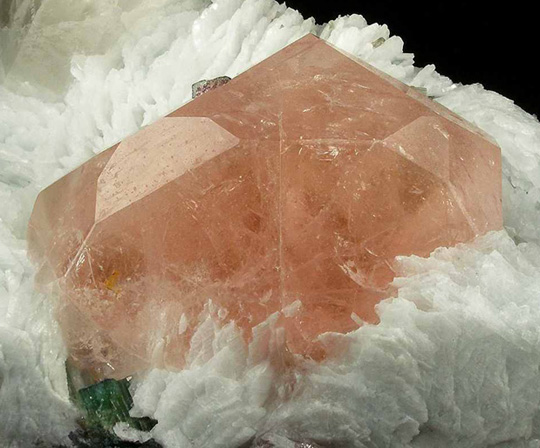Beryl
Beryl is a class of gemstones that have the chemical formula Be3Al2(SiO3)6 - beryllium aluminium cyclosilicate. [1] Some important and famous gemstone varieties are types of beryl.

Morganite - a variety of beryl
Photo by Rob Lavinsky, iRocks.com - image lic. under CC-BY-SA-3.0
Beryls are typically hard (hardness 7.5-8 on the Mohs scale) and often suited to the fabrication of cut gems. Beryl is a cyclosilicate and beryl stones can often occur in the attractive form of hexagonal prisms.
Various colored beryl varieties are possible - and the color variations are caused by mineral impurities. Here is a list of beryl varieties:
Aquamarine (pale Blue/turquoise) - colored by iron (Fe2+) impurities. Is sometimes heat treated to enhance the color. Sometimes known simply as "aqua".
Bixbite (aka. Red Beryl) - colored by manganese (Mn3+) impurities. Bixbite / Red beryl is extremely rare and has only been found in a few locations worldwide. Prices for top quality faceted red beryl have been known to be $10,000 per carat [1] and the best material is said to come from rhyolites in Utah, USA. [2] [3]
Emerald - emerald green, of course! The most valuable beryl. Green color comes from chromium impurities. Emerald is more prone to flaws than other beryl varieties and large flawless stones are rare.
Golden beryl (yellow-gold, sometimes categorized together with Heliodor) - colored by iron (Fe3+) impurities.
Goshenite - "pure" beryl, colorless - no mineral impurities. Relatively inexpensive and not typically used as a gemstone. It has on occasion been found fraudulently backed with green foil in a sly attempt to pass it off as high-grade emerald, which, also being a beryl, has many of the same physical properties.
Heliodor (greenish yellow) - iron, sometimes uranium (less common.) Darker colored stones are more valuable.
Maxixe (pronounced Mah-she-she) - this deep indigo / cobalt blue beryl was discovered in 1917 in Brazil. The color fades quite quickly on exposure to light and the original mine was abandoned, its location then being lost. Maxixe has a realistic claim to being the most mysterious of the beryls: Even after extensive testing in 1974, the Bell Laboratory was not able to ascertain the exact cause of its color. [4] Maxixe has been found to contain impurities of iron (predominantly), caesium, zinc, lithium, rubidium and boron. [5]
Morganite (aka pink beryl, pink emerald, rose beryl) - colored pink by manganese impurities. Named after J.P. Morgan, banker and mineral collector. Morganite also contains caesium and lithium, but these are not believed to be responsible for its coloration. Morganite is generally one of the more costly beryls; though not as expensive as emerald. [2] The color of morganite fades after prolonged exposure to sunlight, thus rendering fine, intensely colored stones more rare. [6] Although sometimes found flawless, morganite often contains minor inclusions. Morganites may have been treated with oil in order to mask flaws - and such treatments should be declared by sellers.
Peach Beryl or Champagne Beryl - an orange-pink variety of morganite beryl.
Vanadium beryl (green, colored by Vanadium (V3+) impurities. [8]
Depending on the minerals present in the beryl, there may also be more or less flaws. Emerald is typically brittle, and less often flawless than other beryl varieties. [1] This is because the chromium ions responsible for the coloration of the emerald, have the effect of weakening the crystal's structure, rendering brittle and highly prone to flaws. Aquamarine sometimes produces large, flawless gems: a flawless 879.5 carat step cut aquamarine is in the British Museum of Natural History. [2]
Beryls are often found in association with quartz, feldspar, muscovite, lepidolite, spodumene, amblygonite, tourmaline, topaz, cassiterite, columbite and tantalite. [9]
Beryl Group Minerals
It's important to note the subtle distinction between beryl and beryl group minerals, which can be a cause for confusion. Beryl has the chemical formula Be3Al2(SiO3)6 as mentioned above. All the gemstones listed above are varieties of beryl, having the same overall chemical formula but slight impurities giving rise to the various color varieties. The beryl group - below - contains four (or five) minerals:
Beryl -Be3Al2(SiO3)6 - as described above.
Pezzottaite - a rare, recently discovered "raspberry red to pink" beryl group mineral conaining cesium and lithium. Pezzottaite has the chemical formula Cs(Be2Li)Al2(Si6O18).
Bazzite - Be3Sc2Si6O18 - Deep blue or blue-green in color; the coloration being caused by scandium. Rare.
Stoppaniite - Be3Fe2Si6O18 - extremely rare, not yet found at gem quality (?).
A fifth, indialite - (Al2Si)Mg2(Al2Si4)O18 - is considered by some to be a member of the beryl group. [10]
The name "beryl" is believed to have originated with the ancient Sanskrit word veruliyam [11]

Beryl from Gilgit, Pakistan.
Photo by Gia.cossa - lic. under CC-BY-SA-2.5
Beryl - Sources Referenced:
[1] http://en.wikipedia.org/wiki/Beryl
[2] http://www.emporia.edu/earthsci/amber/go340/beryl.htm
[3] http://www.theimage.com/gemstone/beryl/beryl.html
[4] http://www.minsocam.org/ammin/AM61/AM61_100.pdf
[5] http://gemologyproject.com/wiki/index.php?title=Maxixe
[6] http://www.tradeshop.com/gems/beryl.html
[7] http://www.minerals.net/work/morganit.htm
[8] http://www.minerals.net/gemstone/gemstone/beryl/beryl.htm
[9] http://rruff.geo.arizona.edu/doclib/hom/beryl.pdf
[10] "Pezzottaite from Ambatovita, Madagascar: A New Gem Mineral" - Gems and Gemology, Winter 2003 (GIA)
[11] http://www.gemtradenet.com/Education/heliodor.aspx
Back to the Gemstones List home page - over 160 gemstones explored!
Please feel free to link to this page - copy / paste the text below: (click to select)
Privacy Policy | Cookie Policy | GDPR | About This Site / Terms

© gemstoneslist.com


